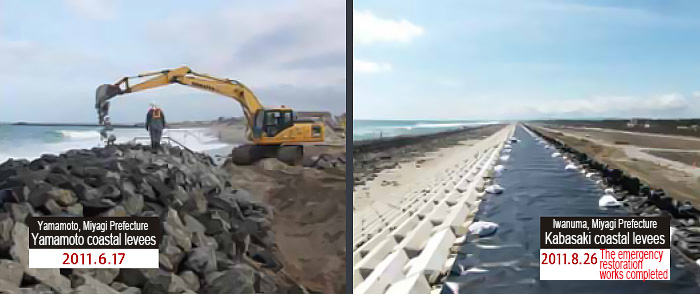The Bureau stated to investigate the extent of damage in the affected area from the second day following the earthquake.
The Bureau promptly made a construction contract, following the “emergency limited tender” procedure authorized only in case of emergency such as natural disasters, and started restoration in cooperation with local construction companies, etc.
Construction of a temporary bridge for the Kesen Ohashi Bridge on Route 45 in Rikuzentakata of Iwate Prefecture was completed in 61 days, much faster than a standard construction period of 120 days.
Emergency restoration works of the levees of inland rivers, such as the severely affected levee of the Eaigawa River in Osaki, Miyagi Prefecture, etc., was also completed before the flood season.
4. Temporary Restoration
TEC-FORCE dispatched
More than two hundred members of TEC-FORCE arrived at the affected areas to investigate the extent of damage.
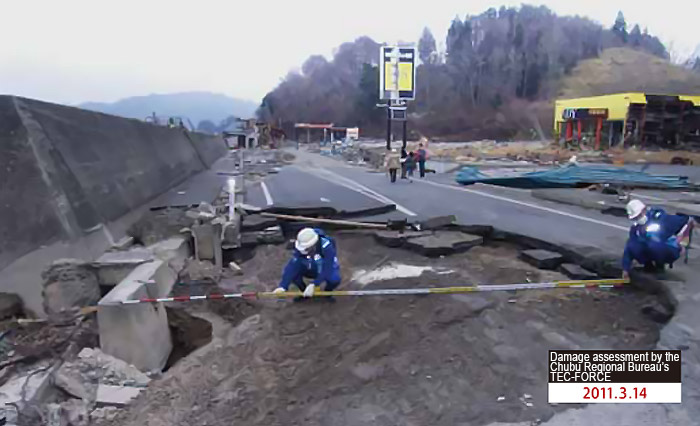
The disaster management specialists gathered from the MLIT Regional Bureaus in Japan were scrambled for the cracked roads, collapsed slopes, fallen bridges, and destroyed harbors.
More than 200 members of this Technical Emergency Control Force, called TEC-FORCE for short, arrived at the affected areas two days after the disaster, to investigate the extent of damage. This fast initial response enabled fast temporary restoration works in early stage.
The members of the TEC-FORCE were also dispatched to the municipalities as support groups; they were engaged in extensive field of activities: gathering information about the damage, drainage by pumper trucks, coordination with the JSDF, receiving or procurement of relief supplies and equipment, etc.

A collapsed bridge was replaced by a temporary bridge to allow traffic.
To ensure safe traffic at the earliest possible time, a temporary bridge was used in restoration works.
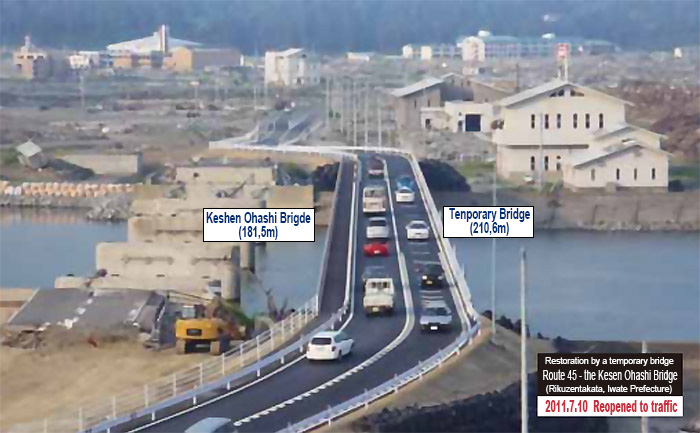
Route 45, which runs along the Pacific coast, was cut in many places by the massive tsunami. In some places, the damage was so devastating that the bridge girders were swept away. Temporary restoration works were undertaken from the place where the road clearance works had been completed. A detour or temporary bridge was introduced where the bridge was lost. Construction of a total 210.6 m temporary bridge, replacing the Kesen Ohashi Bridge (Rikuzentakata, Iwate Prefecture), was started following the dredging of the river; it was completed only in 61 days. The temporary bridge was opened to two-lane traffic on July 10.
A couple of factors contributed to the “fast” temporary restoration works: the constructors were able to start their works immediately after the earthquake; the construction method studied on-site was fed back and incorporated into the restoration strategy, and immediately applied to the construction method, such as the installation of an temporary panel bridge, etc.

Emergency restoration works at 1,195 river facilities in four months.
The emergency restoration works were undertaken for severely stricken river levees which had lost their original form, etc.
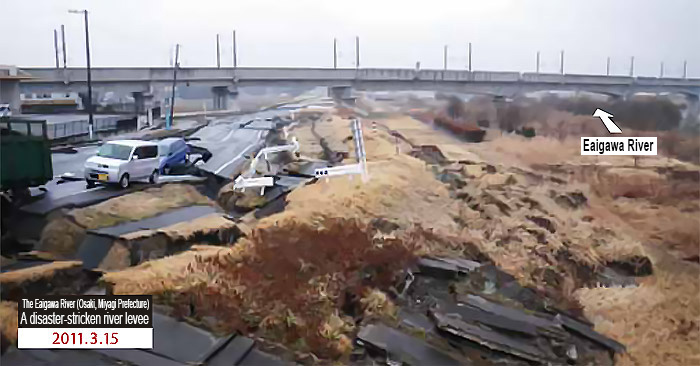
The massive earthquake and tsunami also devastated rivers. In nine rivers of five river systems within the jurisdiction of the MLIT Tohoku Regional Bureau, 1,195 facilities, such as levees and sluiceways, were damaged.
The damaged facilities were temporarily restored immediately after the earthquake, in order to prevent a secondary disaster. Among others, 29 severely affected facilities underwent the “emergency restoration works”, which reinforced the facilities with additional embankments or concrete blocks. The first emergency restoration works were completed in the Eaigawa River on April 2, and all other emergency restoration works were completed by July 11.
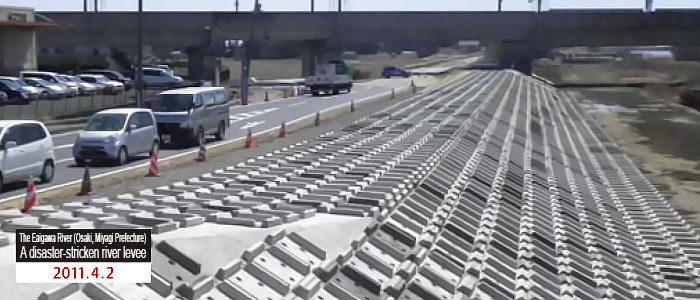
Recovery of marine transportation was achieved by temporary restoration works.
The transportation volume at the affected ports showed recovery of 70% in September, as compared with the volume in the preceding year.
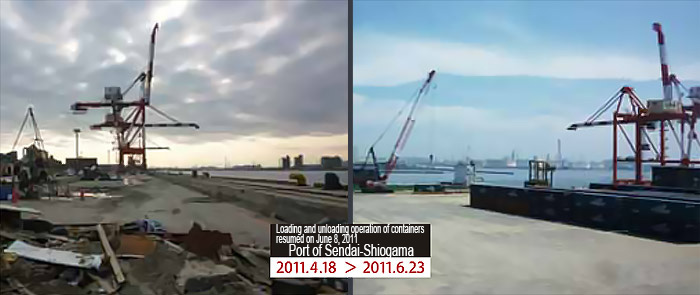
There is a great demand for marine transportation to Tohoku, which includes fuels necessary to generate electricity, livestock feed, raw material for manufacturing industries such as steel, and some products. Daily necessities are also transported to Tohoku by container ships. Marine transportation is closely integrated into the region’s community life and economy. In order to restore the function of ports and harbors as soon as possible, the temporary restoration works were undertaken at very early stage. The interrupted marine distribution network was restored in September, six months after the earthquake. The cargo volume showed a recovery of 70% as compared to the preceding year.
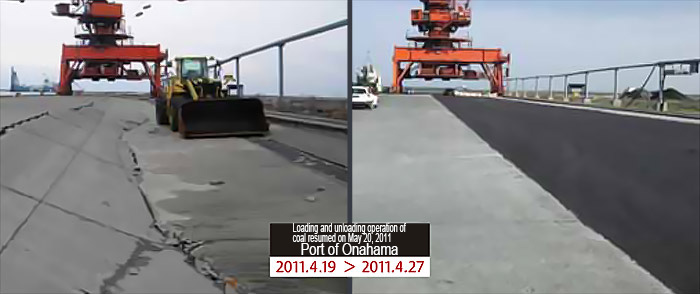
Emergency restoration works of total 19,970 m coastal levees.
In the midst of fear of aftershocks and tsunami, emergency restoration works were undertaken for coastal levees in seven sections of four coasts.
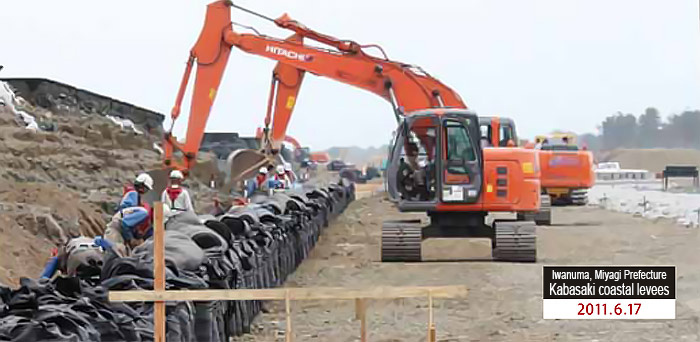
The tsunami devastated the south Sendai Bay coast; coastal levees were damaged in many places, and shoreline was shifted toward inland. Urban areas including the city of Sendai and associated important infrastructure including the JR Joban Line, Route 6, Sendai Airport, etc. are nested behind the affected coastline; therefore, fast restoration was necessary. Emergency restoration works began in April for the coastlines of Sendai, Natori, Iwanuma, and Yamamoto. Construction workers undertook the restoration works while making sure of their own safety with life-jacket on and always paying attention to tsunami warnings on the radio. The coastal levees to be restored prevent sea water flooding at high tides, sea water erosion toward inland area, and protect the coast from high wave. The restoration works were completed toward the end of August.
